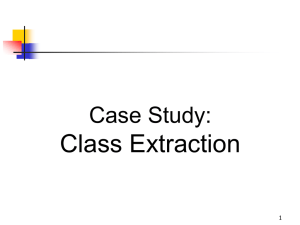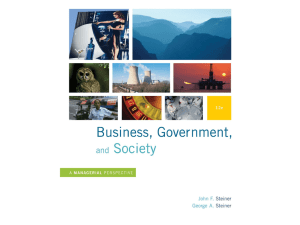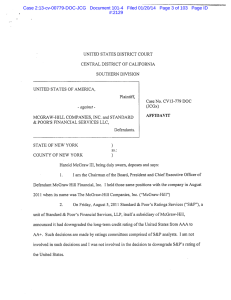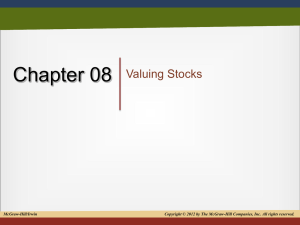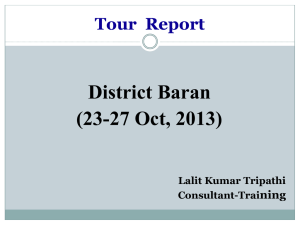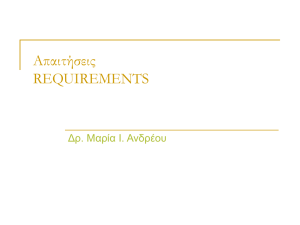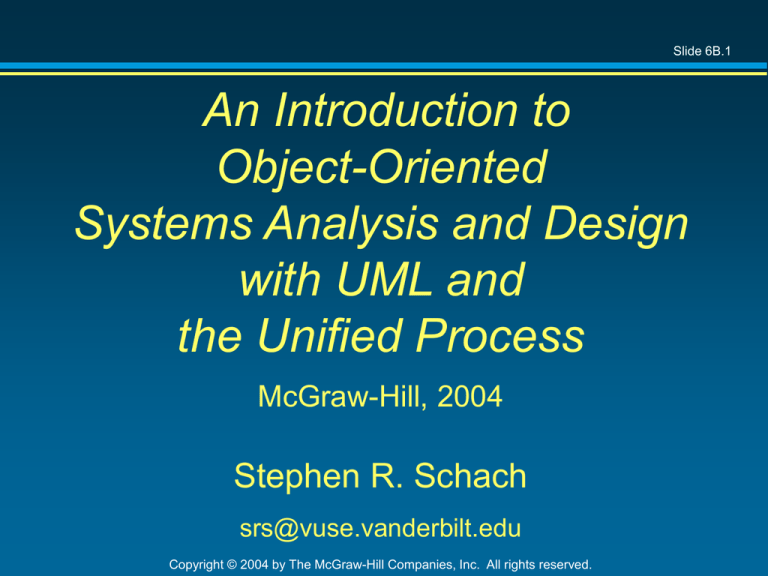
Slide 6B.1
An Introduction to
Object-Oriented
Systems Analysis and Design
with UML and
the Unified Process
McGraw-Hill, 2004
Stephen R. Schach
srs@vuse.vanderbilt.edu
Copyright © 2004 by The McGraw-Hill Companies, Inc. All rights reserved.
CHAPTER 6 — Unit B
Slide 6B.2
THE ANALYSIS WORKFLOW I
Copyright © 2004 by The McGraw-Hill Companies, Inc. All rights reserved.
Slide 6B.3
Continued from Unit 6A
Copyright © 2004 by The McGraw-Hill Companies, Inc. All rights reserved.
Fifth Iteration of the Initial Class Diagram (contd)
Slide 6B.4
Copyright © 2004 by The McGraw-Hill Companies, Inc. All rights reserved.
Dynamic Modeling
Slide 6B.5
Dynamic modeling is the third step in object-oriented
analysis
A statechart is constructed that reflects all the
operations performed by or to the information
system
The operations are determined from the scenarios
Copyright © 2004 by The McGraw-Hill Companies, Inc. All rights reserved.
The Concept of State
Slide 6B.6
The state of an information system is a particular set
of values of the attributes of that system
– The state is often represented by a specific screen
Each event causes the system to move from state to
state, that is, it causes a transition between states
Example: Microsoft Word
– The state is the current screen
– An event is to select (say) Font from the Format Menu
– The Font screen is then the new state
Copyright © 2004 by The McGraw-Hill Companies, Inc. All rights reserved.
Initial Dynamic Model: Osbert Oglesby
Initial statechart
Copyright © 2004 by The McGraw-Hill Companies, Inc. All rights reserved.
Slide 6B.7
Initial Dynamic Model: Osbert Oglesby (contd)
Slide 6B.8
The solid circle (top left) represents the initial state
The white circle with the small black circle inside
(top right) represents the final state
States other than the initial and final states are
represented by rectangles with rounded corners
The arrows represent transitions from state to state
– Example: The arrow from the initial state to the state
labeled Osbert Oglesby Information System Loop
Copyright © 2004 by The McGraw-Hill Companies, Inc. All rights reserved.
Initial Dynamic Model: Osbert Oglesby (contd)
Slide 6B.9
In state Osbert Oglesby Information System
Loop, one of five events can occur:
– Osbert can choose one of five options: buy a painting, sell
a painting, print a report, update a fashionability
coefficient, or quit
These possibilities are indicated by the five events:
–
–
–
–
–
buy painting selected
sell painting selected
print report selected
update fashionability selected
quit selected
Copyright © 2004 by The McGraw-Hill Companies, Inc. All rights reserved.
Initial Dynamic Model: Osbert Oglesby
Slide 6B.10
The initial main menu in the target Osbert Oglesby
information system
Copyright © 2004 by The McGraw-Hill Companies, Inc. All rights reserved.
Initial Dynamic Model: Osbert Oglesby (contd)
Slide 6B.11
Suppose that Osbert clicks on Buy a painting in the
menu
– The event buy painting selected has now occurred
– The system moves from its current state, Osbert Oglesby
Information System Loop, to the state Buying a
Painting
In Buying a Painting state, Osbert can
– Buy a masterpiece, masterwork, or other painting
Copyright © 2004 by The McGraw-Hill Companies, Inc. All rights reserved.
Initial Dynamic Model: Osbert Oglesby (contd)
Slide 6B.12
The Osbert Oglesby information system moves from
state to state when an event occurs
– In each state, Osbert performs one of the operations
supported by that state
This continues until Osbert clicks on option Quit
while the system is in state Oglesby Information
System Loop
– At this time the information system enters the final state
(represented by the white circle containing the small black
circle)
– This terminates execution of the statechart
Copyright © 2004 by The McGraw-Hill Companies, Inc. All rights reserved.
Dynamic Modeling (contd)
Slide 6B.13
Traditionally there is a dynamic model for each
class, rather than for the system as a whole, as in
this case study
– However, objects in information systems rarely move from
one class to another class
Accordingly, a dynamic model for the information
system as a whole is appropriate
Copyright © 2004 by The McGraw-Hill Companies, Inc. All rights reserved.
Extracting Boundary Classes
Slide 6B.14
It is usually easy to extract boundary classes
– Each input screen, output screen, and printed report is
generally modeled by a boundary class
Copyright © 2004 by The McGraw-Hill Companies, Inc. All rights reserved.
Initial Boundary Classes: Osbert Oglesby
Slide 6B.15
One screen should be adequate for all four Osbert
Oglesby use cases:
–
–
–
–
Buy a Painting
Sell a Painting
Print a Report
Modify a Fashionability Coefficient
Thus there is one initial boundary class
– User Interface Class
Copyright © 2004 by The McGraw-Hill Companies, Inc. All rights reserved.
Initial Boundary Classes: Osbert Oglesby (contd)
Slide 6B.16
Consider again the first iteration of the main menu of
the user-interface screen
The five commands correspond precisely to the five
events in the statechart
Copyright © 2004 by The McGraw-Hill Companies, Inc. All rights reserved.
Initial Boundary Classes: Osbert Oglesby (contd)
Slide 6B.17
This is a graphical interface, which needs special
software
Copyright © 2004 by The McGraw-Hill Companies, Inc. All rights reserved.
Initial Boundary Classes: Osbert Oglesby (contd)
Slide 6B.18
However, a textual interface runs on all computers
Copyright © 2004 by The McGraw-Hill Companies, Inc. All rights reserved.
Initial Boundary Classes: Osbert Oglesby (contd)
Slide 6B.19
There are three reports:
– The purchases report
– The sales report
– The future trends report
Each of these has to be modeled by a separate
boundary class because the content of each report
is different
Copyright © 2004 by The McGraw-Hill Companies, Inc. All rights reserved.
Initial Boundary Classes: Osbert Oglesby (contd)
Slide 6B.20
There are thus three report boundary classes
– Purchases Report Class
– Sales Report Class
– Future Trends Report Class
Copyright © 2004 by The McGraw-Hill Companies, Inc. All rights reserved.
Initial Boundary Classes: Osbert Oglesby (contd)
Slide 6B.21
There are therefore four boundary classes
Copyright © 2004 by The McGraw-Hill Companies, Inc. All rights reserved.
Extracting Control Classes
Slide 6B.22
It is also usually easy to extract control classes
– Each nontrivial computation is generally modeled by a
control class
Copyright © 2004 by The McGraw-Hill Companies, Inc. All rights reserved.
Initial Control Classes: Osbert Oglesby
Slide 6B.23
In the case study there are four computations
– Determining the maximum price that Osbert should offer
for a
» Masterpiece
» Masterwork, or
» Other painting
– Determining if there is a new trend in art purchases
Copyright © 2004 by The McGraw-Hill Companies, Inc. All rights reserved.
Initial Control Classes: Osbert Oglesby
There are thus four initial control classes:
–
–
–
–
Compute Masterpiece Price Class
Compute Masterwork Price Class
Compute Other Painting Price Class
Compute Future Trends Class
Copyright © 2004 by The McGraw-Hill Companies, Inc. All rights reserved.
Slide 6B.24
Initial Control Classes: Osbert Oglesby (contd)
Slide 6B.25
Here are the initial control classes
Copyright © 2004 by The McGraw-Hill Companies, Inc. All rights reserved.
Refining the Use Cases: Osbert Oglesby
Slide 6B.26
The class diagram reflects that the pricing algorithm
treats the three types of paintings differently
Accordingly, use case Buy a Painting needs to be
refined into three separate use cases
– Buy a Masterpiece
– Buy a Masterwork
– Buy Other Painting
Therefore, the description of the Buy a Painting use
case must be split into three separate descriptions
Copyright © 2004 by The McGraw-Hill Companies, Inc. All rights reserved.
Refining the Use Cases: Osbert Oglesby (contd)
Slide 6B.27
The Produce a Report use case also needs to be
refined
– The purchases report and the sales report use simple data
extraction— the future trends report involves computation
– All three reports use their own boundary classes
Copyright © 2004 by The McGraw-Hill Companies, Inc. All rights reserved.
Refining the Use Cases: Osbert Oglesby (contd)
Slide 6B.28
For both these reasons, the Produce a Report use
case must be refined into three use cases
– Produce a Purchases Report
– Produce a Sales Report
– Produce a Future Trends Report
The description of the use case must be split into
three separate descriptions
Copyright © 2004 by The McGraw-Hill Companies, Inc. All rights reserved.
Third Iteration of the Use-Case Diagram
Slide 6B.29
Copyright © 2004 by The McGraw-Hill Companies, Inc. All rights reserved.
Class Extraction (contd)
The description of class extraction is complete
We now therefore return to the Unified Process
Copyright © 2004 by The McGraw-Hill Companies, Inc. All rights reserved.
Slide 6B.30
Use-Case Realization
Slide 6B.31
The process of extending and refining use cases is
called use-case realization
Copyright © 2004 by The McGraw-Hill Companies, Inc. All rights reserved.
Use-Case Realization (contd)
Slide 6B.32
The verb “realize” is used at least 3 different ways:
– Understand (“Harvey slowly began to realize that he was
in the wrong classroom”);
– Receive (“Ingrid will realize a profit of $45,000 on the
stock transaction”); and
– Accomplish (“Janet hopes to realize her dream of starting
a computer company”)
In the phrase “realize a use case,” the word “realize”
is used in this last sense
– It means to accomplish (or achieve) the use case
Copyright © 2004 by The McGraw-Hill Companies, Inc. All rights reserved.
Use-Case Realization (contd)
Slide 6B.33
The realization of a specific scenario of a use case
is depicted using an interaction diagram
– Either a sequence diagram or collaboration diagram
Various versions of the use case Buy a Masterpiece
appear in the following slides
Copyright © 2004 by The McGraw-Hill Companies, Inc. All rights reserved.
Buy a Masterpiece Use Case
Use case diagram
Copyright © 2004 by The McGraw-Hill Companies, Inc. All rights reserved.
Slide 6B.34
Buy a Masterpiece Use Case (contd)
Description
of the use
case
Copyright © 2004 by The McGraw-Hill Companies, Inc. All rights reserved.
Slide 6B.35
Buy a Masterpiece Use Case (contd)
Slide 6B.36
Class diagram (classes that enter into the use case)
Copyright © 2004 by The McGraw-Hill Companies, Inc. All rights reserved.
Buy a Masterpiece Use Case (contd)
Slide 6B.37
The four classes that enter into this use case are:
– User Interface Class
» This class models the user interface
– Compute Masterpiece Price Class
» This class models the computation of the price Osbert should offer
– Masterpiece Class
» The computation involves comparing the masterpiece being
considered with the masterpieces that have been previously
auctioned
– Auctioned Painting Class
» These masterpieces are all instances of Auctioned Painting
Class
Copyright © 2004 by The McGraw-Hill Companies, Inc. All rights reserved.
Buy a Masterpiece Use Case (contd)
Slide 6B.38
The Seller does not interact directly with the
information system
– Instead, the Seller provides data that Osbert enters into
the information system
This is indicated in the note (the rectangle with the
top right-hand corner turned over)
– There is a dashed line from the note to the item to which it
refers, the Seller in this case
Copyright © 2004 by The McGraw-Hill Companies, Inc. All rights reserved.
Buy a Masterpiece Use Case (contd)
Slide 6B.39
Scenario (one possible instance of the use case)
Copyright © 2004 by The McGraw-Hill Companies, Inc. All rights reserved.
Buy a Masterpiece Use Case (contd)
Slide 6B.40
A working information system uses objects, not
classes
– Example: A specific masterpiece is not represented by
Masterpiece Class but rather by an object, a specific
instance of Masterpiece Class
Such an object is denoted by : Masterpiece Class
Copyright © 2004 by The McGraw-Hill Companies, Inc. All rights reserved.
Buy a Masterpiece Use Case (contd)
A class diagram shows the classes in the use case
and their relationships
– It does not show the objects nor the sequence of
messages as they are sent from object to object
Slide 6B.41
Something more is needed
Copyright © 2004 by The McGraw-Hill Companies, Inc. All rights reserved.
Buy a Masterpiece Use Case (contd)
Collaboration diagram (of the realization of the
scenario of the use case)
Copyright © 2004 by The McGraw-Hill Companies, Inc. All rights reserved.
Slide 6B.42
Buy a Masterpiece Use Case (contd)
Slide 6B.43
The collaboration diagram shows the objects as well
as the messages, numbered in the order in which
they are sent in the specific scenario
The direction of the arrow shows the direction in
which the information flows
Copyright © 2004 by The McGraw-Hill Companies, Inc. All rights reserved.
Slide 6B.44
Continued in Unit 6C
Copyright © 2004 by The McGraw-Hill Companies, Inc. All rights reserved.

